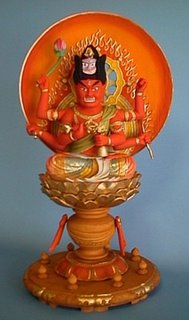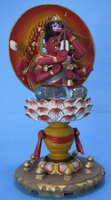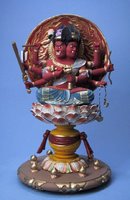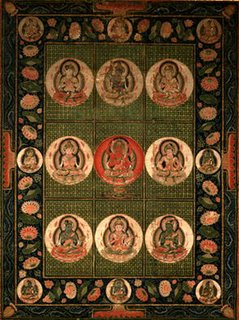:::::::::::::::::::::::::::::::::::::::::::::::::::::::::::::::::::::::::::::::::::::::::::::::::::::::::::::::::::::::::::
Aizen Myo-O 愛染明王 Aizen Myō-ō

C: http://www.sakai.zaq.ne.jp/piicats/aizen.htm
Read Mark Schumacher about Aizen in English.
Since the Heian period the most well known Myo-O beside Fudo.
He is considered an incarnation of Dainichi Nyorai, Kongoo Satta, Kongoooo and Kongooai Bosatsu.
In the Shingon sect he is venerated in special ceremonies, Aizenhoo 愛染法、Kyooaihoo 敬愛法.
:::::::::::::::::::::::::::::::::::::::::::::::::::::::::::::::::::::::::::::::::::::::::::::::::::::
- quote
Myoo identified with Dainichi Nyorai or Kongou Satta; The main vow is love and compassion; embodies the perfect state of spiritual concentration leading " Eearthly desires are spiritual awakening. For that, his countenance is full of wrath and violence, however, he has the original vow of great love in his mind.
He has three eyes and six arms carrying various weapons. The three eyes give the achievement of Buddha to common people of the three worlds. The body is red carrying flame of the sun on his back; vanquishes illusions. His hairs are being stuck violently with wrath, and he is carrying a fluke with five hooks over his head; gives health and wealth.

Tenkyu aizen-Myoo
This deity is more popular these days among people because of the meaning of Kanji letter "Aizen" which means "dyed with love". He has an arrow aimed at the Heaven.
(tenkyuu aizen 天弓愛染)

Ryoto aizen-myoo
The another transformation of Aizen Myoo. Aizen Myoo and Fudou Myoo are Combined together holding their both head, meaning the both Myoo.
(ryootoo Aizen 両頭愛染)

Copyright © 2005 KURITA TRADING CO.,LTD
With links to more Myo-O figures.
http://www.butuzou.co.jp/english/aizenmyoo.html
. ryootoo Aizen 両頭愛染 Ryoto Aizen with two heads .
Look at more photos here on my page.
:::::::::::::::::::::::::::::::::::::::::::::::::::::::::::::::::::::::::::::::::::::::::::::::::::::
Aizen on a horse

Nichiren is recording the formal visitation of Aizen and Fudo
Dated the 25th day of the 6th month of the 6th year of Kencho (1254).
Newly authenticated and added to the Gohonzonshu in the 1999 edition.
http://nichirenscoffeehouse.net/GohonzonShu/124.html
:::::::::::::::::::::::::::::::::::::::::::::::::::::::::::::::::::::::::::::::::::::::::::::::::::::
C: Great link about Goma Ceremonies:
[愛染明王の一夜護摩の修法]
愛染明王を本尊としその真言と印、そして明るい赤の衣と四角形の炉を用いて護摩を行うと愛染明王の一夜護摩の修法となり、敬愛や恋愛の達成、異性の獲得に驚異的に効果がある。この場合不動護摩の本尊段の乳木108本のところを108の赤い蓮の花にかえて用いて修法する。
尚、四角の炉を三角の炉に変えて調伏を行うと敵は修法者にさからえなくなり言うがままになってしまうと言われている。
http://www.sakai.zaq.ne.jp/piicats/goma.htm
xxxxxxxxxxxxxxxxxxxxxxxxxxxxxxxxxx
敬愛法(愛染明王) (きょうあいほう)Kyooaihoo
おん まからぎゃ ばさら うしゅにしゃ ばさら さた(と)ば じゃくうんばんこく
密教の五種法、息災・増益・敬愛・調伏・鉤召のうち「敬愛法」(きょうあいほう) がもっとも広範におこなわれたようです。 敬愛法には、「出世間法」と「世間法」の二法あります。 平安貴族や皇族の中には、出世のために相手を殺すような呪術として利用したものも あるようです。しかし、一般的には「夫婦の不和の修復や、かなわぬ恋愛の成就、衆人 からの敬愛の獲得などを願って修されたようです。
「愛染曼荼羅」が、「敬愛法」の主本尊として祈祷の中心になります。

「阿字観」の境地をみました。
金剛薩たは、大日如来です。阿弥陀如来です。また、金剛愛菩薩です。

月輪(がちりん)や、月輪の中の「阿(あ)」字、「吽(うん)」字がポイントです。
愛染明王は、火炎の日輪に座しその上に二つの月輪がある明王画があります。
C: 詳しいことはこちら:
http://www.sakai.zaq.ne.jp/piicats/keiai.htm
:::::::::::::::::::::::::::::::::::::::::::::::::::::::::::::::::::::::::::::::::::::::::::::::::::::
- quote
Aizen Myo’o (King of Lust)
Ragaraja, Buddhist Lord of Passion, traveled from India to Japan, where he transformed into Aizen Myo’o, venerated by Japan’s esoteric Buddhist sects as King of Love, Lust, and Desire, patron of erotic love and sacred sexuality. He helps convert earthly, physical desires into transcendent love and spiritual awakening.
Aizen Myo’o is King of Lust because he helps control it, explore it, or transform it into enlightenment. He is petitioned for assistance with the physical and emotional frustrations of suppressed sexuality. Aizen Myo’o is revered as patron of gay love, but he may be invoked for assistance with any kind of love or romance, including self-love.
Aizen Myo’o has three eyes, six arms, and either one or two heads (with three eyes per head). He wears a crown with a Shishi dog over his wild hair.
- source : shop.hauntedcuriosities.com
:::::::::::::::::::::::::::::::::::::::::::::::::::::::::::::::::::::::::::::::::::::::::::::::::::::::::::::::::::::::::::

source : facebook
:::::::::::::::::::::::::::::::::::::::::::::::::::::::::::::::::::::::::::::::::::::::::::::::::::::::::::::::::::::::::::
H A I K U
kigo for mid-summer
Aizen matsuri 愛染祭 (あいぜんまつり) Aizen festival
..... Aizen mairi 愛染参(あいぜんまいり)Visiting the Aizen temple
Shooman mairi 勝鬘参(しょうまんまいり)visiting temple Shoman-in
Shooman-e 勝鬘会(しょうまんえ)
Festival in honor of Shotoku Taishi, at the temple Shooman-in 勝鬘院, in Osaka.
. . . CLICK here for Photos !
. Reference : Shoman-In Aizendo
:::::::::::::::::::::::::::::::::::::::::::::::::::::::::::::::::::::::::::::::::::::::::::::::::::::

- source : facebook butsuzoo
:::::::::::::::::::::::::::::::::::::::::::::::::::::::::::::::::::::::::::::::::::::::::::::::::::::::
Aizen (Raagaraaja, Ragaraja)
Seit der Heian-Zeit nach Fudoo am besten bekannter Myôô in Japan.
Inkarnation des Dainichi Nyorai, Kongoo Satta, Kongoooo und Kongooai Bosatsu.
Sutra: Yugikyoo (Suutra of all Yogas and Yogiis of the Pavilion with the Vajra-Top)
In der Shingon-Sekte in der Zeremonie "Aizenoohoo" verehrt.
Aizen repräsentiert die Reinen Gefühle, die Reine Liebe.
Er wandelt die irdischen Leidenschaften der Menschen direkt in die rechten Gefühle eines Bosatsu um.
In der Tachikawa-Sekte des Shingon spielt er eine besondere Rolle in den verschiedenen Zeremonien.
Äußerlich furchterregender Gesichtsausdruck, aber er plant immer nur die Erlösung der Menschen von ihren verderblichen Leiden~schaften. Er verwandelt die verschlingende Liebe in die Reine Liebeskraft des religiösen Herzens um. In der Edo-Zeit die Schutzgottheit der käuflichen Damen im Yoshiwara-Viertel.
Da er Waffen in den Händen hält, wurde er von den Samurai besonders verehrt.
Es gibt auch einige Mandalas, in denen Aizen die Zentralfigur ist.
Eine ausführliche Beschreibung über Aizen Myoooo findet sich bei Goepper (4).
Ikonografie:
Roter runder Nimbus mit Flammen oder spezieller Nimbus aus drei Kreisen oder einem großen Kreis, der die Sonne symbolisiert.
Rote Körperfarbe als Ausdruck der Leidenschaften.
Einen Kopf, drei Augen, sechs Arme. Krone mit einem Löwenkopf, über dem auch ein Haken mit fünf Spitzen (gokokoo) sichtbar sein kann.
In den Händen:
Donnerkeil-Glocke, Donnerkeil mit fünf Zacken, Lotusblüte, Pfeil, Bogen u.a.
Die Gegenstände in den Händen beziehen sich auch auf verschiedene esoterische Zeremonien, bei denen Aizen eine Hauptrolle spielt.
In den linken Händen trägt er die Gegenstände der Lehre, also machmal auch das wunscherfüllende Juwel (Gebet um Glück) oder ein Sonnenrad (Gebet um Schutz des eigenen Leibes).
Selten mit drei Köpfen.
Mit Pfeil und Bogen als Gottheit der Liebe.
Nur sitzende Statuen auf einem Lotussockel. Unter dem Sockel eine Vase (kenbyoo), aus der alle Schätze fließen.
Besonders Statuen:
Aizen mit dem Himmlischen Bogen (tenkyuu Aizen)
Aizen mit einem Bogen mit aufgelegtem Pfeil zum Himmel gerichtet "als würde er auf die Helligkeit aller Sterne zielen" [Goepper (4)]. Daher auch frei als "Der nach den Sternen zielende Aizen" (shatenzoo) übersetzt.
Der Bogen wird hoch über dem Kopf gehalten.
Insgesamt sechs Arme. Mittlere Hände mit Donnerkeil und Donnerkeil-Glocke. Eine rechte Hand mit Lotusblüte.
Eine der linken Hände hält manchmal einen abgeschnittenen Kopf.
Möglicherweise eine Version des indischen Liebesgottes Kama bzw. des römischen Cupid.
Fünf Finger großer Aizen
(goshiryoo Aizen 五指量愛染)
「五指量(ごしりょう)の愛染王」
「瑜祇経」の愛染王の印に、「五股(鈷)の印」があります。 東寺に伝えられた最極の秘印だったそうです。 ここでは、梵字が書けませんので、音だけです。 短の「ウン」、重の「ウン」
比叡山でも、愛染王の五股印と明(みょう)があります。
①「吽(ウン)」・・・右手指を上にして、両手を組む
②「多(タ)」・・・両中指をまっすぐに立てて合わせる
③「枳(キ)」・・・両人差し指を鉤(かぎ)のようにする。
④「吽(ウン)」・・・③から両親指と小指を立てる。
⑤「弱(シャ)」・・・さらに両人差し指を開きます。
(両薬指を手のひらの中にいれる。これが最極秘密の口伝)
http://www.sakai.zaq.ne.jp/piicats/keiai.htm
Look at the statue here / 写真はこちら
鎌倉時代の1297(永仁5)年、称名寺でつくられた五指量の愛染明王の坐像です。五指量像とは、左手親指の幅を5本分あわせた長さ、あるいは親指から小指までの手の長さの幅でつくられて、本来、白檀製の像で、お守りとして身につけておくものでした。愛染明王は、さまざまな悪いものを消滅させていく強い攻撃力をもっていますが、五指量像はその力をお守りに使っています。称名寺伝来のこの愛染明王坐像は、称名寺長老の念持仏と伝えられ、金銅製で、厨子に納められています。随所に精巧なつくりのみられる優品で、国の重要文化財に指定されています。台座底面に「永仁五年二月廿七日、金沢寺是作、大工左近入道浄胤、子息藤右衛門尉秀吉」とあり、作者がわかります。
県立金沢文庫主任学芸員 永井晋
/kanazawa/02kuban/0302
:::::::::::::::::::::::::::::::::::::::::::::::::::::::::::::::::::::::::::::::::::::::::::::::::::::::
- quote
Aizen, Mantra-König der Liebe
Aizen Myōō wird oft schreckenerregender als Fudō dargestellt. Erkennbar an seiner feuerroten Hautfarbe und an Pfeil und Bogen (neben anderen Waffen) kann er bis zu sechs Arme und Beine besitzen. Auch er erfuhr vor allem im esoterischen Buddhismus große Verehrung. Sein Name bedeutet zwar wörtlich „Mantra-König der Liebe“, doch bedeutet das lediglich, dass er die irdischen Leidenschaften der Menschen in die rechten Gefühle eines Bosatsu verwandelt — und das mit seinen Methoden.

Wie die meisten anderen Myōōs (außer Fudō) dürfte Aizen mit dem Rückgang des esoterischen Buddhismus in der Edo-Zeit an Bedeutung verloren haben und ist daher heute verhältnismäßig wenig bekannt. Doch noch in der Edo-Zeit fühlten sich Liebende — oder die, die mit der Liebe handelten — zu ihm hingezogen. Er galt zu dieser Zeit als der Beschützer der Geishas in Yoshiwara, dem Freudenviertel von Edo.
- source : www.univie.ac.at/rel_jap - Uni Wien
:::::::::::::::::::::::::::::::::::::::::::::::::::::::::::::::::::::::::::::::::::::::::::::::::::::::::::::::::::::::::::
Aizen mit zwei Köpfen (ryoozu Aizen, ryootoo Aizen)
Einer der Köpfe ist Fudo Myo selbst.
Buddhastatuen ... Who is Who,
Ein Wegweiser zur Ikonografie von japanischen Buddhastatuen
by Gabi Greve 1994
:::::::::::::::::::::::::::::::::::::::::::::::::::::::::::::::::::::::::::::::::::::::::::::::::::::
[ . BACK to WORLDKIGO . TOP . ]
[ . BACK to DARUMA MUSEUM TOP . ]
:::::::::::::::::::::::::::::::::::::::::::::::::::::::::::::::::::::::::::::::::::::::::::::::::::::








7 comments:
pilgrimage to 17 temples of
Aizen Myo-O in Saikoku Western Japan.
西国愛染十七霊場
01 . 愛染堂勝鬘院
02. 東光寺
03. 鏑射寺 - Kaburai-Ji
04. 摩耶山天上寺
05. 大龍寺
06. 正覚院
07. 大聖寺
08. 東寺
09. 覚性律庵
10. 高野山増福院
11. 愛染院
12. 久修園院
13. 西大寺
14. 宝山寺
15. 施福寺
16. 福智院
17. 金剛三昧院
.
Kaburaiji 鏑射寺 Kaburai-Ji - Kobe
.
Aizen with two heads, one of them is Fudo Myo-O
Aizen mit zwei Köpfen (ryoozu Aizen, ryootoo Aizen)
Einer der Köpfe ist Fudo Myo-O.
.
ryootoo Aizen 両頭愛染 Ryoto Aizen with two heads
.
Nr. 10 - 五色山 Goshikisan 聖心寺 Seishin-Ji
. 津軽弘法大師霊場 - Tsugaru Kobo Daishi Reijo
Pilgrimage to 23 Kobo Daishi temples in Tsugaru .
.
愛染明王の五色の綱 - Aizen Myo-O and the rope in five colors
It is connected to the statue of Aizen in the hall.
.
MORE about the temple.
.
Asahi reports that in Wakayama Prefecture, where theft of sacred artifacts from unoccupied temples has become a major problem, high-school students from the area have used 3-D printing technology to present one affected site with a replica of a stolen Buddhist statue.
In late 2010, 11 relics dating from the early Edo period (1603–1868) were stolen from the local temple of Enpukuji. Although 3 of the items were later found being advertised for sale, and bought back by local residents, the fear of a repeat theft means that rather than being returned to Enpukuji, the items have been placed in the care of Wakayama Prefectural Museum.
Starting last September, students from nearby Wakayama Technical High School took laser measurements from one of the statues, a 51 cm rendering of the divinity Aizen Myōō, and 3-D printed an exact replica. Museum staff painted the new statue to be as close as possible to the original. Locals who received the gift said: "We plan to revere this new statue forever, as an embodiment of the real thing."
More photos at the link (in Japanese).
Aizen Myōō is one of the Five Wisdom Kings revered in Esoteric Buddhism.
http://www.asahi.com/articles/photo/AS20150221000966.html
.
The novel 愛染かつら "Aizen Katsura" by 川口松太郎 Kawaguchi Matsutaro refers to this temple.
Tokyo
本覚山 Hongakuzan 自性院 Jisho-In 宝光寺 Hoko-Ji
台東区谷中6-2-8 / 6 Chome-2-8 Yanaka, Taitō ward
.
https://gokurakuparadies.blogspot.jp/2017/03/gofunai-temples-52-and-53.html
.
A legend from Nobeoka, Miyazaki
Around 1820, a young woman was bewitched by a curse of a disease.
A priest could drive the illness out.
He said he had relocated the curse to the statue of 伊良原地蔵 Irahara Jizo.
Then a mountain priest of 金剛院 the Temple Kongo-In did an incantation for healing,
they found it was a bewitchment of a fox.
With a special ritual for 愛染明王 Aizen Myo-O the woman could be healed.
.
https://gokurakuparadies.blogspot.com/2022/10/kongoin-fudo-hikawa.html
.
Saigoku Aizen Deity Pilgrimage 西国愛染霊場
now in my blog
https://gokurakuparadies.blogspot.com/2023/12/saikoku-aizen-reijo-pilgrimage.html
.
Post a Comment